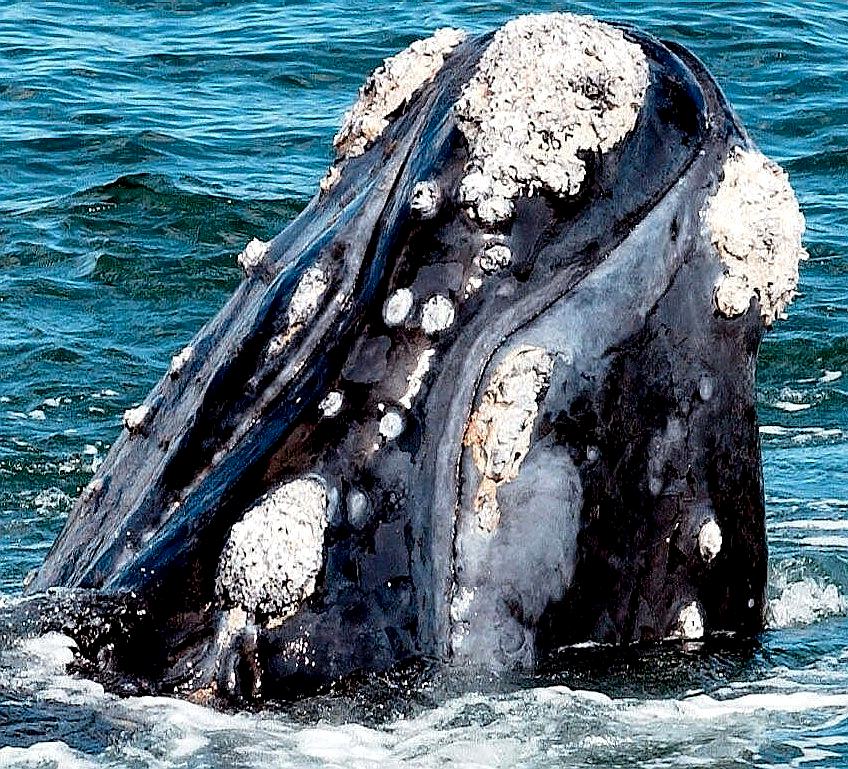
Right whales or black whales are three species of large baleen whales of the genus Eubalaena: the North Atlantic right whale (E. glacialis), the North Pacific right whale (E. japonica) and the Southern right whale (E.
australis).
All members of the family
today have a series of longitudinal folds of skin running from below the mouth back to the navel (except the sei whale and common minke whale, which have shorter grooves). These furrows allow the mouth to expand
considerably when feeding, "permitting them to engorge great mouthfuls of food and water in a single gulp". These "pleated throat grooves" distinguish balaenopterids from other whales.
Rorquals are slender and streamlined in shape, compared with their relatives the right whales, and most have narrow, elongated flippers. They have a dorsal fin, situated about two-thirds the way back. Rorquals feed by gulping in
water and food, and then pushing the water out through the baleen plates with their
tongue, leaving behind the crustaceans, such as krill, and various fish, such as herrings and
sardines - that the feed on.
Gestation in rorquals lasts 11–12 months, so that both mating and birthing occur at the same time of year. Cows give birth to a single calf, which is weaned after 6–12 months, depending on species. Of some species, adults live in small groups, or "pods" of two to five individuals. For example,
humpback whales have a fluid social structure, often engaging behavioral practices in a pod, other times being solitary.
They are adaptable.
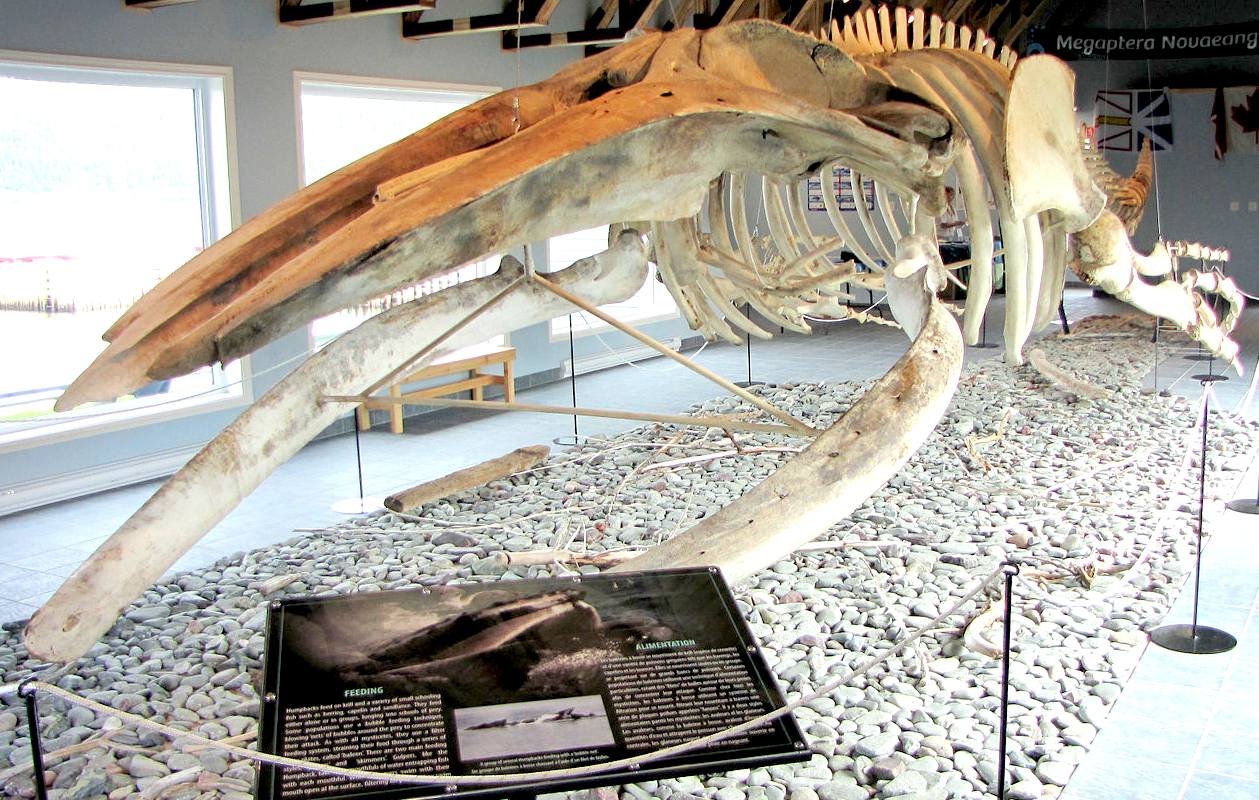
SPLIT
PERSONALITY - This humpback whale skeleton reveals that the jaw is
in two pieces, with left and right bones hinged such as to be able to
spread wider when gulping vast volumes of water. The more seawater and
food that is ingested, the easier it is for these gentle giants to
survive.
EXTREME FEEDING
As well as other methods, rorquals obtain prey by lunge-feeding on bait balls. Lunge feeding is an extreme feeding method, where the whale accelerates to a high velocity and then opens its mouth to a large gape angle. This generates the water pressure required to expand its mouth and engulf and filter a huge amount of water and fish.
Rorquals have a number of anatomical features that enable them to do this, including bilaterally separate
mandibles (split jaw bones), throat pleats that can expand to huge size, and a unique sensory organ consisting of a bundle of mechanoreceptors that helps their brains to coordinate the engulfment action. Furthermore, their large nerves are flexible so that they can stretch and recoil.
This
feature gives rorqual whales the ability to open their mouths so wide that they
are capable of taking in seawater volume greater than their own size in
some cases. Their nerves are packed into a central core area that is surrounded by elastin fibers. Opening the mouth causes the nerves to unfold, and they snap back after the mouth is closed.
According to Potvin and Goldbogen, lunge feeding in rorquals represents the largest biomechanical event on
Earth.
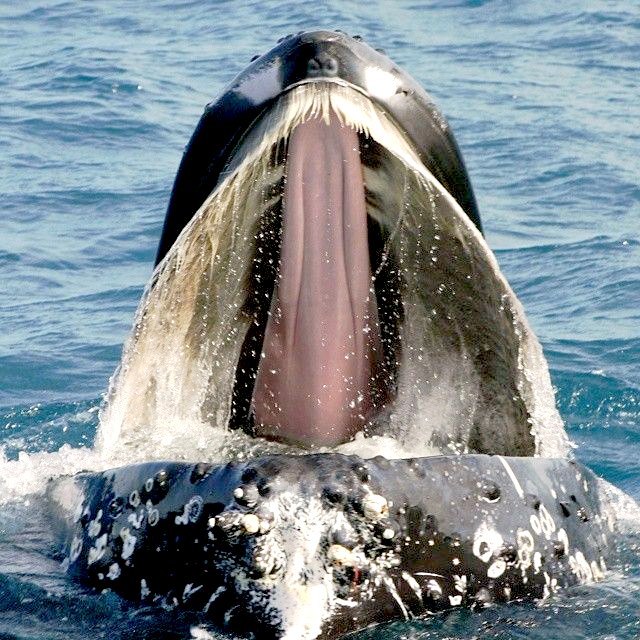
FOLLOW THE FOOD
Distribution is worldwide: the blue, fin, humpback, and the sei whales are found in all major oceans; the common (northern) and Antarctic (southern) minke whale species are found in all the oceans of their respective hemispheres; and either of Bryde's whale and Eden's whale occur in the
Atlantic,
Pacific, and
Indian oceans, being absent only from the cold waters of the
Arctic and Antarctic.
Most rorquals are strictly oceanic: the exceptions are Bryde's whale and Eden's whale (which are usually found close to shore all year round) and the humpback whale (which is oceanic but passes close to shore when migrating). It is the largest and the smallest types — the blue whale and Antarctic minke whale — that occupy the coldest waters in the extreme south; the fin whale tends not to approach so close to the ice shelf; the sei whale tends to stay further north again. (In the northern hemisphere, where the continents distort weather patterns and ocean currents, these movements are less obvious, although still present.) Within each species, the largest individuals tend to approach the poles more closely, while the youngest and fittest ones tend to stay in warmer waters before leaving on their annual migration.
Most rorquals breed in tropical waters during the winter, then migrate back to the polar feeding grounds rich in plankton and krill for the short polar summer.
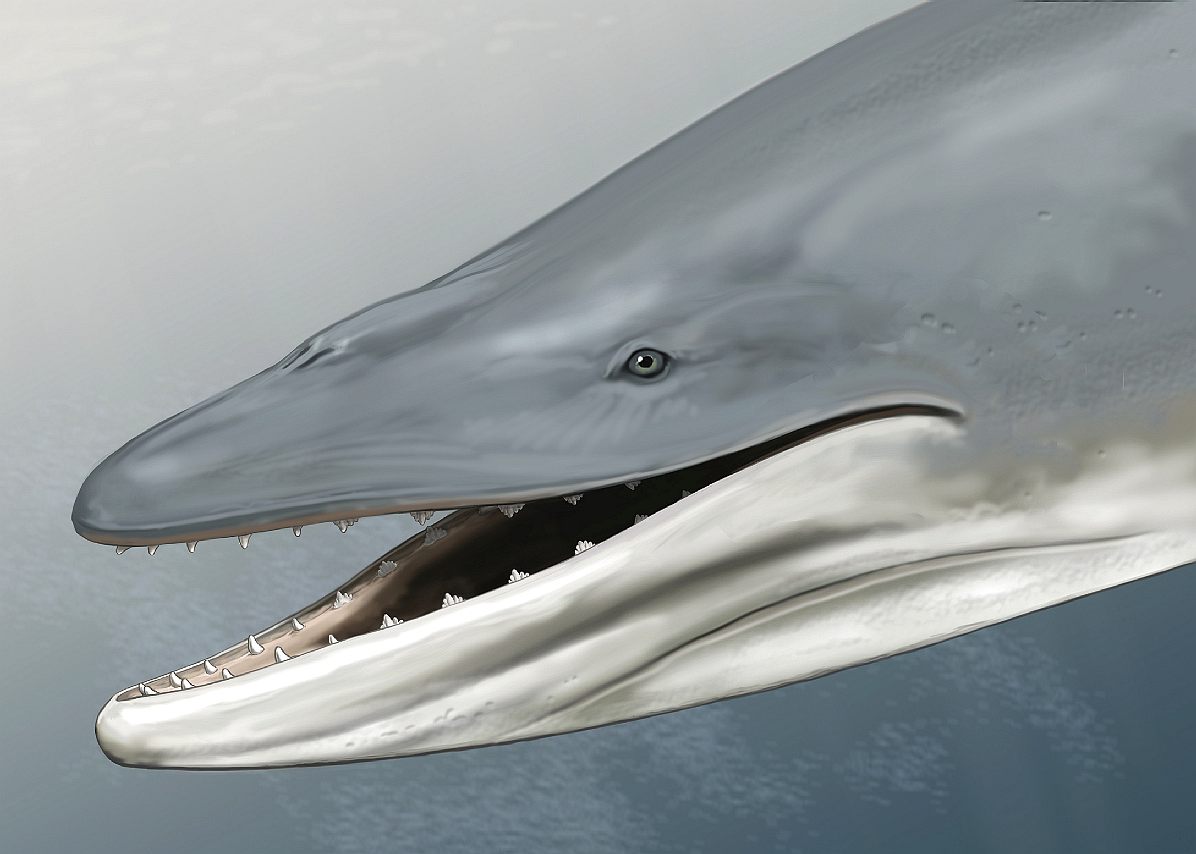
STUDY
2018 - The remains of the second oldest
baleen whale ever found has revealed that early whales may
not have had baleen. A 34-million-year-old whale skull from Antarctica has well-developed gums and teeth, with no evidence of the baleen plates used in filter feeding.
Study co-author Felix Marx is a researcher at the Royal Belgian Institute of Natural
Sciences is quoted as saying: “Llanocetus denticrenatus is an ancient relative of our modern gentle giants, like humpback and blue whales,”
“Unlike them, however, it had teeth, and probably was a formidable predator.”
Study co-author R. Ewan Fordyce is quoted as saying, “Until recently, it was thought that filter feeding first emerged when whales still had teeth. Llanocetus shows that this was not the case.”
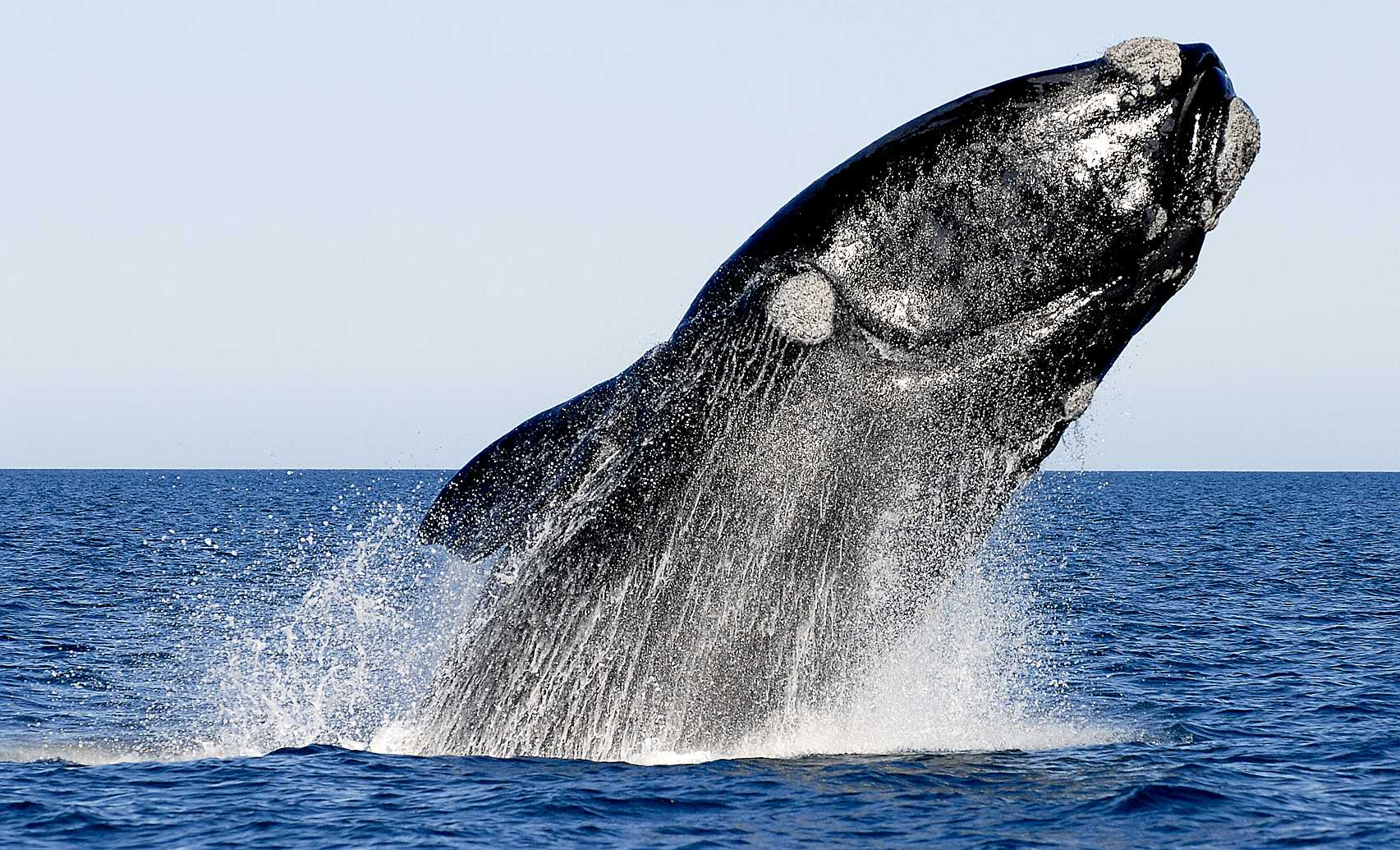
DNA STUDY 2018
Researchers in Germany and Sweden sequenced the DNA of six of the living species, of which there are at least 10.
The relationships are so complicated, however, that the senior researcher Axel Janke said “family tree” is too simple a metaphor. Instead, the species, all part of a group called rorquals, have evolved more into a network, sharing large segments of
DNA with even distant cousins. Scientists expressed surprise that there had been so much intermingling of baleen whales, given the variety of sizes and shapes.
Humpback and sei whales are relatively similar in size, for instance — both usually measuring longer than a school bus. But the blue whale, which is the largest animal to ever live and would dwarf an 18-wheeler, is a close relation to the sei, and relatively distant from the humpback, according to the study, published
in the journal Science
Advances.
The North Atlantic right whales and
bowhead whales split from the other baleens about 28 million years ago; among the rorquals, minke whales seem to have begun diverging more than 10 million years ago; and the blue and sei whales split from the remaining around five million years ago, the study found.
The study of rorqual evolution also defies simple Darwinian theories. Charles
Darwin explained that many species evolved when they became isolated from others of their kind, accumulating genetic differences and adapting to a new environment.
But whales roam the entire ocean, where there are no geographic barriers that would isolate them. Instead, Dr. Janke said, at least some of the whale speciation has been driven by personal taste.
Baleen whales developed sophisticated systems to open their jaws wide enough to suck in almost their own body weight worth of water, along with the tiny creatures swimming or floating in it.
Gray whales are part of the same family, but preferred to eat krill and other organisms, slurping them up as they swam along — which possibly led them to become their own species.
The genomic analysis also showed mating across species, with animals sharing more than 30 percent of one another’s genetic heritage, though their ancestors diverged about 10 million years ago.
The idea that species can intermingle is new, even to scientists, said Scott Edwards, an evolutionary biologist at Harvard University, who was not involved in the new study.
“Ten years ago, most evolutionary biologists would have assumed that a species is a species, especially when they look phenotypically distinct,” Dr. Edwards said. Recent research has shown that humans, too, are the product of species intermingling. There are varying levels of
Neanderthal and Denisovan DNA across the human population.
Dr. Janke said he was also struck by the wide range of genetic diversity he saw within whale species. Genetic diversity helps animals survive change. “The whaling moratorium, where they stopped whaling in 1978, came just in time to prevent this biodiversity from being genetically more monotonous,” he said. “If that had been the case, it would have been difficult to envision how the species could survive.”
This study is the first genome-scale comparison of so many baleen whales, but it won’t be the last. A team at the American Museum of Natural History in New York and the University of California, Riverside, is preparing an even more detailed analysis of more animals and species.
To a whale biologist, the idea of two whale species mixing is as mind-bending as the image of a chimp mating with a gorilla.
Blue and fin whales, for instance, differ in size, color and body shape. The thought of them breeding and reproducing is an interesting concept.
In the case of the blue whale and the fin whale, genetic analyses have shown that the female hybrid carried a fetus and had mated with a blue whale. Thus, these two species, as well as other rorquals, may not be entirely reproductively isolated. This is a reproductive strategy, along with the tendency to mate with multiple partners, that potentially provides a means to rapid adaptation to changing circumstances.
Hunting
whales is forbidden by
international
law.
LINKS
& REFERENCE
https://www.nytimes.com/2018/04/04/science/baleen-whales-evolution-genome.html
https://advances.sciencemag.org/content/4/4/eaap9873
https://www.earth.com/news/oldest-baleen-whale-teeth/
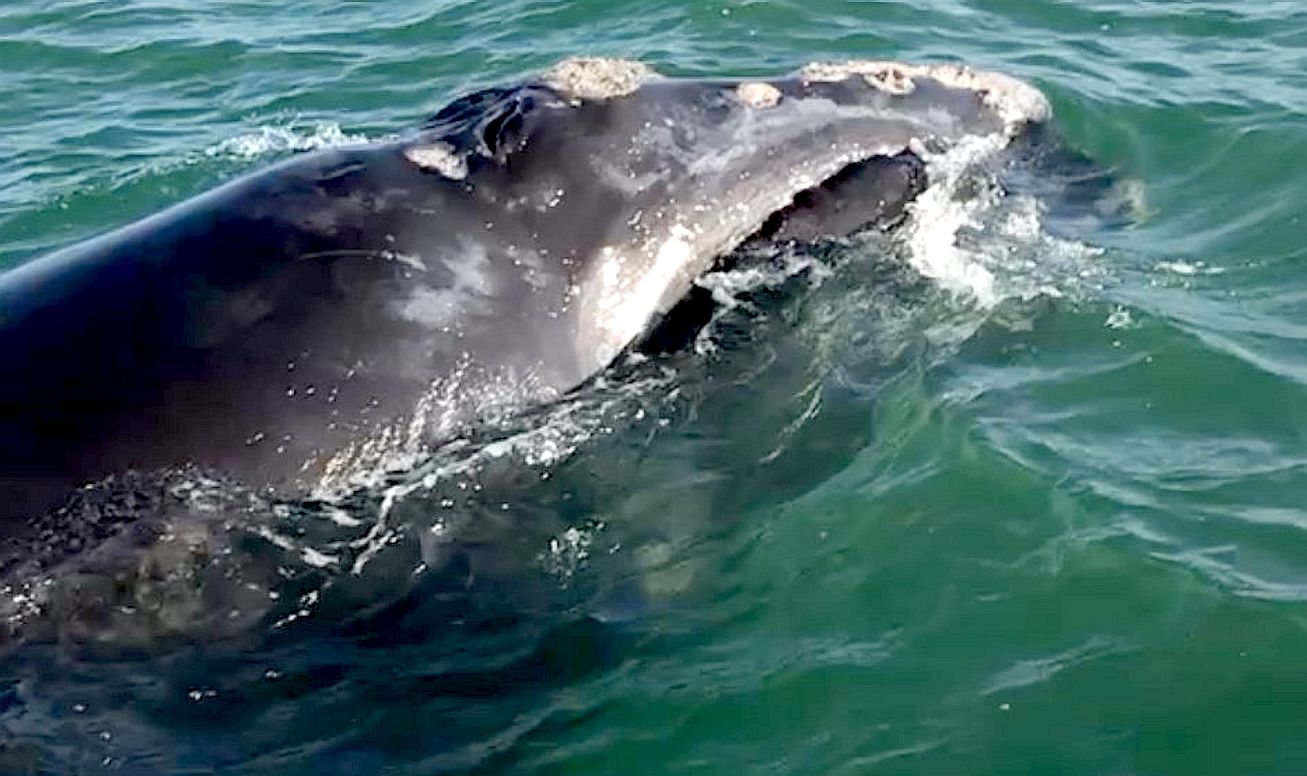
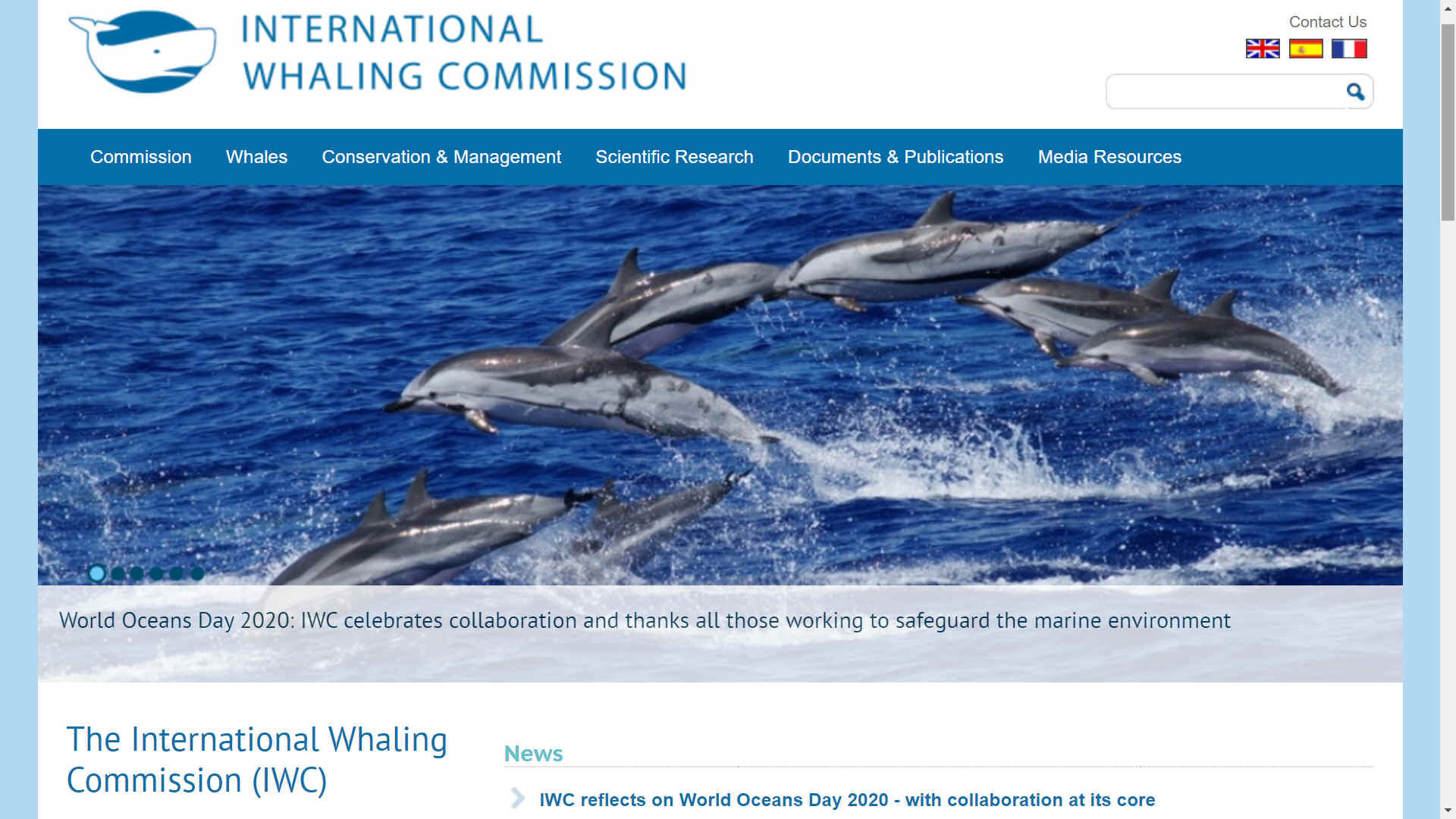
IWC is a voluntary
international organization and is not backed up by treaty, therefore,
the IWC has substantial practical limitations on its authority. First,
any member countries are free to simply leave the organization and
declare themselves not bound by it if they so wish. Second, any member
state may opt out of any specific IWC regulation by lodging a formal
objection to it within 90 days of the regulation coming into force (such
provisions are common in international agreements, on the logic that it
is preferable to have parties remain within the agreements than opt out
altogether). Third, the IWC has no ability to enforce any of its
decisions through penalty imposition.
Please use our
A-Z INDEX to
navigate this site






